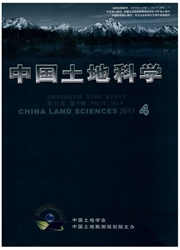

 中文摘要:
中文摘要:
研究目的:基于农地非农化模型,从农户与区县政府两个层面,考察指标供给侧的激励机制及空间效应,以期为地票交易供给侧激励效率的完善提供参考。研究方法:文献法和模型分析法;研究结果:空间上的“指标漂移”受到区域差异的影响,导致农户和区县政府层面上空间激励低效的问题。研究结论:(1)在农户层面,地票增值收益的返还,忽视了宅基地资源价值的空间差异,造成了宅基地退出的空间低效和耕地保护效果的大打折扣;(2)区县政府层面,地票需求者和供给者的双重身份,指标漂移过程中发展权的损失使其缺乏持续供给地票的积极性。(3)供给侧激励的改善需结合地票增值收益的形成和宅基地区位、功能差异,把握地票供给决策的影响因素,形成空间上层次分明、各有侧重的地票供给激励。
 英文摘要:
英文摘要:
The purpose of this paper is to analyze the incentive mechanism and the spatial effects on the supply side of Chongqing’s land coupon system, based on the farmland conversion model and to provide references for improving the efficiency of incentive on land coupon’s supply side. Methods of literature analysis and model analysis are used in the research. The results show that spatial transference of construction land quota is bound to be affected by regional differences, which thereby causes spatial inefficient of economic incentive in both rural households and county-level governments. In the aspect of rural households, economic incentives for farmers neglected the spatial differences of the rural residential land value, and has caused spatial inefficient of rural residential land exit and hampered the performance of cultivated land protection. In the aspect of the county-level governments, there was a lack of efficient incentive for development right with regard to the sustainable land quota supply, considering their dual identities of the supplier and demander. In conclusion, we defined the effective conditions for the income distribution and spatial distribution of land coupon, based on analyzing the incremental benefit formation mechanism of land coupon and the location and function of rural household homestead system. We also argued that incentives with spatial difference should be proposed in the steps of rural residential land exit and land coupon utilization, through evaluating rural residential land value and potential land market demand in the specific county.
 同期刊论文项目
同期刊论文项目
 同项目期刊论文
同项目期刊论文
 期刊信息
期刊信息
